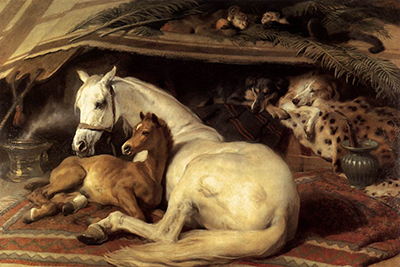The Arab Tent is oil on canvas painting completed in 1866. It depicts horses, dogs and monkeys resting inside a tent. The artwork features an Arab mare with its adorable foal while two Persian greyhounds lay in the background.
The painting featured at the Royal Academy exhibition of 1866 under the title of Mare and Foal-Indian Tent. Even though he initially described it as an Indian Tent, it is clear that the carpet was of Persian origin. It is a rare work celebrating Oriental fashion influences on Victorian England. Inspiration As a member of the Humane Society, Edwin Henry Landseer was a prolific animal painter who did several artworks featuring both domestic animals and wildlife. His favourite subjects included deers, horses, and dogs. Landseer’s work was popular with Victorian elite and did several projects for the Queen.
A major characteristic of Landseer's paintings is the emphasis on animals as living beings often depicted in different types of emotional expressions. For instance, the dog in Suspense looks forlorn while the two hounds in The Two Dogs look lively and excited. He used the same approach in the Arab Tent by depicting the foul as scared while the mother is relaxed and reassuring. Meanwhile, the two pairs of dogs and monkeys remain nonchalantly attentive. Since Landseer was beholden to animals, the painting only alludes to the owner’s presences through imagery. Adjacent to the foal is a furnace emitting smoke while its pose indicates activities in the background.
Edwin Henry Landseer was a prodigy who won the award for the best animal drawings at the Society of Arts at the age of 11 years. He went on to study works by Raphael and Elgin, whose works had recently arrived in England. The influence of Raphael on his work is evident in the use of light colours and clarity of compositions and form, which was a hallmark of Raphael's artworks.
Landseer travelled widely visiting zoos and forests around the country. In 1924, he visited Scotland to work for Sir Walter Scott and was enchanted by the deer. He would visit Scotland several times during his life for inspiration from the incredible landscape and scenery. The most remarkable of Scottish influences is The Monarch of the Glen. The Arab Tent was acquired by Sir Richard Wallace in 1879 but was donated to the Royal Academy by Lady Wallace in 1897. It is now part of The Wallace Collection, which is based in Hertford House in London. Even though some paintings are not on display, visitors can request them from the staff.




